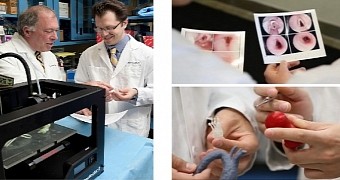The trachea, also known as the windpipe, is the tube that connects the upper respiratory tracks (connected to the throat) to the lungs. So you can imagine that any harm coming to it is bad.
Normally, to treat tracheal diseases sometimes needs surgeons to remove the affected tracheal segment, which in turn requires cartilage transplants or long-term hospitalization while the tissue regenerates naturally.
Actually removing the windpipe, however, has never been done, until now. Todd Goldstein of the Feinstein Institute for Medical Research, worked with some associates to do just that for their latest patient.
It took a year for the project to yield success, but the custom-designed tracheal replacement prosthesis ultimately proved a success.
So what was missing all these years? 3D printing, apparently. The doctors used a MakerBot 3D printer to produce a prosthetic replacement.
The 3D printed tracheal prosthesis
They combined 3D printing technology with a patient's own cells to pull it off. First they created a mixture of cells called chondrocytes, fed them nutrients, and then bound them together with collagen. That substance was then applied to a 3D-printed scaffold.
The cartilage cells seeded on the graft retained their biological capability and later showed that they proliferated at the same rate as native cells.
It took some trial and error to produce a tracheal replacement that withstand sneezes, coughs and other changes in pressure, without sacrificing the flexibility.
They had to modify the MakerBot Replicator 2X Experimental 3D Printer to use PLA and the biomaterial, but MakerBot itself provided assistance with that, as well as with the design optimization in real time.
In the end, Goldstein and his colleagues created a series of tracheal segments made of living cells. These segments can be adjusted to suit the anatomy of each patient.
There are empty segments, control segments without cells, and segments combined with living cells. They can be bioprinted without the cells dying or otherwise losing the cellular properties expected of healthy tracheal cartilage.
It may not have been easy to basically create a new type of surgery from scratch, but there we go: human ingenuity at its most bullheaded.
The time frame
It took one year for the new procedure to be created, since the engineering part was more than a bit challenging. Having a technology (3D printing) that could examine, touch, feel and then redesign the trachea within minutes or hours definitely paid off.
The Food and Drug Administration (FDA) still needs to approve the method, but a compassionate therapy exception could be gained since this is the first method to cure trachea damage/illness, meaning that patients themselves will be allowed to choose whether or not to go through with it.

 14 DAY TRIAL //
14 DAY TRIAL //